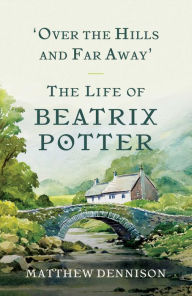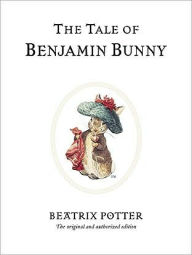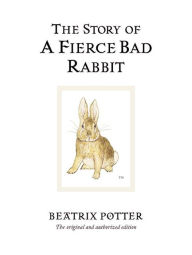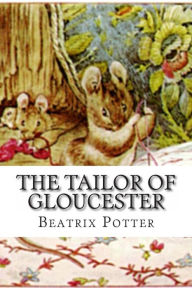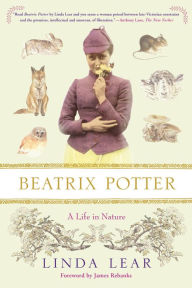One Touch of Nature: Beatrix Potter and the World She Made

“Here comes Peter Cottontail, hopping down the bunny trail. Hippetty, hoppetty, Easter’s on its way,” so sang cowboy crooner Gene Autry in a hit record of the 1950s. Because of the song, which seemed to be playing anywhere you could find jellybeans, marshmallow Peeps, and candy eggs, I grew up a little confused about rabbits. Was Peter Cottontail another name for the Easter Bunny? Did he have siblings, since my mother sometimes spoke of Flopsy, Mopsy, and Cottontail? And was he the same as this Peter Rabbit I sometimes heard people talk about?
As a child, I never did resolve these questions, partly because no one properly introduced me to Beatrix Potter’s most famous character. Matters actually grew more confused when, in elementary school, I did read about Joel Chandler Harris’s Br’er Rabbit, Howard R. Garis’s Uncle Wiggily, and yet another Peter in Thornton W. Burgess‘s animal stories. Still, of arguably the most popular English children’s book of all time — not a single memory. Neither did I know anything of its author, the subject of Matthew Dennison’s excellent short biography, Over the Hills and Far Away: The Life of Beatrix Potter.
Over the Hills and Far Away: The Life of Beatrix Potter
Over the Hills and Far Away: The Life of Beatrix Potter
Hardcover
$18.25
$27.95
Only as a parent in the 1980s did I finally acquire The Tale of Peter Rabbit and share it with my three young sons at bedtime. In fact, as so often happens with preschoolers, we shared it over and over and over again. Surprisingly, this was no hardship: I was as enchanted as any three-year-old. After all, the book had — has — everything: A daredevil, if slightly neurotic, protagonist, a tragic back-story (“Your father . . . was put in a pie by Mrs. McGregor”), the lure of a forbidden paradise, a relentless and murderous adversary, hairbreadth escapes, and, finally, a return to all the warm-lit coziness of home. Who can forget the penultimate picture of Mother Rabbit drawing camomile tea from a big pot suspended over a blazing fire, as her three “good” children look on?
Only as a parent in the 1980s did I finally acquire The Tale of Peter Rabbit and share it with my three young sons at bedtime. In fact, as so often happens with preschoolers, we shared it over and over and over again. Surprisingly, this was no hardship: I was as enchanted as any three-year-old. After all, the book had — has — everything: A daredevil, if slightly neurotic, protagonist, a tragic back-story (“Your father . . . was put in a pie by Mrs. McGregor”), the lure of a forbidden paradise, a relentless and murderous adversary, hairbreadth escapes, and, finally, a return to all the warm-lit coziness of home. Who can forget the penultimate picture of Mother Rabbit drawing camomile tea from a big pot suspended over a blazing fire, as her three “good” children look on?
The Tale of Benjamin Bunny
The Tale of Benjamin Bunny
Hardcover $8.99
Not least, Potter provided sequels and touches of what those who’ve majored in English would call intertextuality. In The Tale of Benjamin Bunny Peter’s bold cousin lures him, rather reluctantly, back to Mr. McGregor’s garden and further escapades ensue. In The Tale of the Flopsy Bunnies we learn that Benjamin married Flopsy and that a grown-up, rather bourgeois Peter now tends his own garden, his days of adventure long behind him. Or are they? In The Tale of Mr. Tod, the two cousins team up again to rescue baby bunnies who have been kidnapped by Tommy Brock the badger. This story begins with one of Potter’s sly jokes: When Peter asks how many bunnies have been taken, Benjamin answers, “Seven, Cousin Peter, and all of them twins!”
Not least, Potter provided sequels and touches of what those who’ve majored in English would call intertextuality. In The Tale of Benjamin Bunny Peter’s bold cousin lures him, rather reluctantly, back to Mr. McGregor’s garden and further escapades ensue. In The Tale of the Flopsy Bunnies we learn that Benjamin married Flopsy and that a grown-up, rather bourgeois Peter now tends his own garden, his days of adventure long behind him. Or are they? In The Tale of Mr. Tod, the two cousins team up again to rescue baby bunnies who have been kidnapped by Tommy Brock the badger. This story begins with one of Potter’s sly jokes: When Peter asks how many bunnies have been taken, Benjamin answers, “Seven, Cousin Peter, and all of them twins!”
The Story of a Fierce Bad Rabbit
The Story of a Fierce Bad Rabbit
Hardcover $6.99
Such sly humor, as well as a gentle but pervasive irony, runs through Potter’s work. In The Tale of Jemima Puddle-Duck children quickly grasp the secret intent of the elegant gentleman with black prick ears and sand-colored whiskers, while the dimwitted but lovable Jemima never does. Similarly, the little girl in The Tale of Mrs. Tiggy-Winkle only belatedly recognizes that an old washerwoman — who has recently laundered Peter Rabbit’s shrunken blue coat — is actually a hedgehog. Note, too, the visual/verbal humor that opens that brilliantly titled work intended for the very young, The Story of a Fierce Bad Rabbit. Its first picture depicts what seems a perfectly ordinary, innocent-looking bunny. But then the narrator draws our attention to his “savage whiskers, and his claws, and his turned-up tail.” No doubt about it, only the most naïve and guileless would be taken in by this dangerous, wild beast. In The Pie and the Patty-Pan, set in the Lake District village where she lived, Potter actually turns her hand to French farce, producing a head-spinning comedy of errors. Even Potter’s liking for multisyllabic words and fancy phrases — such as “soporific” and “lamentable want of discretion” — always carries with it a whiff of intended humor. She does, however, avoid surreal nonsense or cruel satire: Her heroes may look like animals, but they are otherwise only human, all too human.
Helen Beatrix Potter was born in 1866 into a well-to-do Victorian family that resided in London. Growing up, she was surrounded by servants, homeschooled by governesses, and kept isolated from the world. She had no friends, except four-legged ones, largely because her parents preferred it that way. So Beatrix lived in her imagination and in the fairy tales and eerie legends she heard from her nannies. “Throughout her life,” notes Matthew Dennison, “she believed in the existence of the Loch Ness monster.”
In adolescence, young Beatrix entertained herself by reading (Walter Scott, Shakespeare, Jane Austen) and keeping a journal, one written in a private cipher so that she could frankly record her observations about art, the world, her family and the animals she kept in her third-floor nursery. “Rabbits are creatures of warm volatile temperament but shallow and absurdly transparent. It is the naturalness, one touch of nature, that I find so delightful in Mr. Benjamin Bunny, though I frankly admit his vulgarity.” In these pages — a good sampling is Beatrix Potter’s Journal, edited by Glen Cavaliero — she gradually perfected what Cavaliero rightly calls “the supple precision” of her prose.
Throughout her teens and twenties Potter was forced to rely on her six-years-younger brother, Bertram, and various rabbits and tamed mice for companionship. Above all, though, she found respite from her straitened, narrow existence in the glorious exaltation of drawing and painting. Art quickly became a compulsion. As Potter once said, “I cannot rest. I must draw, however poor the result.” She was, in fact, both a prodigy and prodigious. Her early subjects, naturally enough, were often her own pets or — when the family was on holiday in the country — insects, farm animals and wildflowers. She worked obsessively to get every detail right, to replicate whatever she observed with the fidelity and accuracy of a scientist. There are, for instance, 250 exceptionally detailed, almost microscopically precise paintings of fungi, i.e., mushrooms and toadstools. By contrast, she always found it difficult to draw people — just compare the bland, doll-faced Lucie in Mrs. Tiggy-Winkle with the vivacious hedgehog.
In 1890 Beatrix bought Mr. Benjamin H. Bouncer, who eventually became the model for Peter Rabbit. Initially, she related Peter’s encounter with Mr. McGregor in a long, illustrated letter to Noel Moore, the five-year-old son of a former governess who was ill in bed, then followed up with a letter to his younger brother about the angling mishaps of the frog, Jeremy Fisher. Years later, she decided to turn Peter’s story into a book, which she had privately published in 1901 at her own expense. This original black-and-white edition of The Tale of Peter Rabbit — a first printing of 250 copies, followed by an additional printing of 200 — is now impossibly rare. Somehow, though, this vanity project, this rich girl’s folly, won praise from Arthur Conan Doyle, no less. In 1902 a London publisher, Frederick Warne & Company, then rather cautiously agreed to bring out a commercial edition of the book. By the end of 1903, The Tale of Peter Rabbit had sold 50,000 copies. Today a good copy of the Warne first printing would set you back $20,000.
Such sly humor, as well as a gentle but pervasive irony, runs through Potter’s work. In The Tale of Jemima Puddle-Duck children quickly grasp the secret intent of the elegant gentleman with black prick ears and sand-colored whiskers, while the dimwitted but lovable Jemima never does. Similarly, the little girl in The Tale of Mrs. Tiggy-Winkle only belatedly recognizes that an old washerwoman — who has recently laundered Peter Rabbit’s shrunken blue coat — is actually a hedgehog. Note, too, the visual/verbal humor that opens that brilliantly titled work intended for the very young, The Story of a Fierce Bad Rabbit. Its first picture depicts what seems a perfectly ordinary, innocent-looking bunny. But then the narrator draws our attention to his “savage whiskers, and his claws, and his turned-up tail.” No doubt about it, only the most naïve and guileless would be taken in by this dangerous, wild beast. In The Pie and the Patty-Pan, set in the Lake District village where she lived, Potter actually turns her hand to French farce, producing a head-spinning comedy of errors. Even Potter’s liking for multisyllabic words and fancy phrases — such as “soporific” and “lamentable want of discretion” — always carries with it a whiff of intended humor. She does, however, avoid surreal nonsense or cruel satire: Her heroes may look like animals, but they are otherwise only human, all too human.
Helen Beatrix Potter was born in 1866 into a well-to-do Victorian family that resided in London. Growing up, she was surrounded by servants, homeschooled by governesses, and kept isolated from the world. She had no friends, except four-legged ones, largely because her parents preferred it that way. So Beatrix lived in her imagination and in the fairy tales and eerie legends she heard from her nannies. “Throughout her life,” notes Matthew Dennison, “she believed in the existence of the Loch Ness monster.”
In adolescence, young Beatrix entertained herself by reading (Walter Scott, Shakespeare, Jane Austen) and keeping a journal, one written in a private cipher so that she could frankly record her observations about art, the world, her family and the animals she kept in her third-floor nursery. “Rabbits are creatures of warm volatile temperament but shallow and absurdly transparent. It is the naturalness, one touch of nature, that I find so delightful in Mr. Benjamin Bunny, though I frankly admit his vulgarity.” In these pages — a good sampling is Beatrix Potter’s Journal, edited by Glen Cavaliero — she gradually perfected what Cavaliero rightly calls “the supple precision” of her prose.
Throughout her teens and twenties Potter was forced to rely on her six-years-younger brother, Bertram, and various rabbits and tamed mice for companionship. Above all, though, she found respite from her straitened, narrow existence in the glorious exaltation of drawing and painting. Art quickly became a compulsion. As Potter once said, “I cannot rest. I must draw, however poor the result.” She was, in fact, both a prodigy and prodigious. Her early subjects, naturally enough, were often her own pets or — when the family was on holiday in the country — insects, farm animals and wildflowers. She worked obsessively to get every detail right, to replicate whatever she observed with the fidelity and accuracy of a scientist. There are, for instance, 250 exceptionally detailed, almost microscopically precise paintings of fungi, i.e., mushrooms and toadstools. By contrast, she always found it difficult to draw people — just compare the bland, doll-faced Lucie in Mrs. Tiggy-Winkle with the vivacious hedgehog.
In 1890 Beatrix bought Mr. Benjamin H. Bouncer, who eventually became the model for Peter Rabbit. Initially, she related Peter’s encounter with Mr. McGregor in a long, illustrated letter to Noel Moore, the five-year-old son of a former governess who was ill in bed, then followed up with a letter to his younger brother about the angling mishaps of the frog, Jeremy Fisher. Years later, she decided to turn Peter’s story into a book, which she had privately published in 1901 at her own expense. This original black-and-white edition of The Tale of Peter Rabbit — a first printing of 250 copies, followed by an additional printing of 200 — is now impossibly rare. Somehow, though, this vanity project, this rich girl’s folly, won praise from Arthur Conan Doyle, no less. In 1902 a London publisher, Frederick Warne & Company, then rather cautiously agreed to bring out a commercial edition of the book. By the end of 1903, The Tale of Peter Rabbit had sold 50,000 copies. Today a good copy of the Warne first printing would set you back $20,000.
The Tailor of Gloucester
The Tailor of Gloucester
Paperback $7.99
Potter’s writing career only began in her mid-thirties, at a time when she must have given up on the idea of marriage. Not that she ever repined. “Self containment,” writes Dennison, “was an important facet of her make-up. It surfaces in her fictional characters: Jeremy Fisher, Mrs. Tiggy-Winkle, Mrs. Tittlemouse. All live apparently, fulfilled, largely solitary lives.” But on July 26, 1905, Dennison tells us, Potter reread the end of Persuasion, Jane Austen’s autumnal masterpiece about a woman who, late in life, is unexpectedly given the chance of marital happiness. The previous day, we learn, her editor Norman Warne had proposed to her and she had accepted. He and Potter had worked closely together on a half-dozen books, including her personal favorite, The Tailor of Gloucester, the tiny Dickensian classic, set on Christmas Eve, about how grateful mice unexpectedly repay an act of kindness. She had even used a doll’s house Warne had built as the model for the one in The Tale of Two Bad Mice.
Alas, the engagement was heartbreakingly brief: Warne grew mysteriously ill and suddenly died on August 25th of lymphatic leukemia. In the overromanticized biopic Miss Potter, Renee Zellweger falls to pieces after this tragic death. So did Potter briefly, but as her business letters show, she was always a resolute and tough-minded woman. By October she was back working on The Tale of Jeremy Fisher, which, besides its unlucky hero, features appearances by Mr. Alderman Ptolemy Tortoise and one Sir Isaac Newton (a newt, of course). Determined to make a fresh start, she then moved into a farmhouse in the Lake District.
She didn’t live at Hill Top full time, bowing to the wishes of her parents that she spend stretches with them in London. Still, she visited her farm as often she could and in the next eight years experienced “a sustained burst of intense creativity” that was, as Dennison says, “balanced by her growing knowledge and love of the farmer’s life in the North Country. Between 1905 and 1913, she wrote a clutch of her best-known stories: the tales of Tom Kitten, Jemima Puddle-duck, Samuel Whiskers, Ginger and Pickles, the Flopsy Bunnies, Mrs Tittlemose, Timmy Tiptoes, Mr. Tod and Pigling Bland.” She also composed her whimsical “Miniature Letters,” sent to various children, in one of which Mrs. McGregor threatens to inform the police if Peter keeps trespassing on her property.
Considering how prolific and successful that decade in Potter’s life had been, what happened next may come as something of a surprise: She and William Heelis — her Lake District lawyer and business consultant — grew increasingly fond of each other’s company, and after four years of friendship, were married in 1913. From that date, Beatrix Potter essentially stopped writing. For the next thirty years, until her death at in 1943 at age seventy-seven, she would be Mrs. William Heelis, landowner, sheep breeder, and, above all, preservationist. She yearned to protect the landscape and countryside she loved. “With the ‘little books’ behind her,” writes Dennison, “her focus had shifted. She balanced romance with common sense, and made plans . . . to ensure the long-term survival of her new farms and age-old farming traditions by bequeathing both to the National Trust.”
Potter’s writing career only began in her mid-thirties, at a time when she must have given up on the idea of marriage. Not that she ever repined. “Self containment,” writes Dennison, “was an important facet of her make-up. It surfaces in her fictional characters: Jeremy Fisher, Mrs. Tiggy-Winkle, Mrs. Tittlemouse. All live apparently, fulfilled, largely solitary lives.” But on July 26, 1905, Dennison tells us, Potter reread the end of Persuasion, Jane Austen’s autumnal masterpiece about a woman who, late in life, is unexpectedly given the chance of marital happiness. The previous day, we learn, her editor Norman Warne had proposed to her and she had accepted. He and Potter had worked closely together on a half-dozen books, including her personal favorite, The Tailor of Gloucester, the tiny Dickensian classic, set on Christmas Eve, about how grateful mice unexpectedly repay an act of kindness. She had even used a doll’s house Warne had built as the model for the one in The Tale of Two Bad Mice.
Alas, the engagement was heartbreakingly brief: Warne grew mysteriously ill and suddenly died on August 25th of lymphatic leukemia. In the overromanticized biopic Miss Potter, Renee Zellweger falls to pieces after this tragic death. So did Potter briefly, but as her business letters show, she was always a resolute and tough-minded woman. By October she was back working on The Tale of Jeremy Fisher, which, besides its unlucky hero, features appearances by Mr. Alderman Ptolemy Tortoise and one Sir Isaac Newton (a newt, of course). Determined to make a fresh start, she then moved into a farmhouse in the Lake District.
She didn’t live at Hill Top full time, bowing to the wishes of her parents that she spend stretches with them in London. Still, she visited her farm as often she could and in the next eight years experienced “a sustained burst of intense creativity” that was, as Dennison says, “balanced by her growing knowledge and love of the farmer’s life in the North Country. Between 1905 and 1913, she wrote a clutch of her best-known stories: the tales of Tom Kitten, Jemima Puddle-duck, Samuel Whiskers, Ginger and Pickles, the Flopsy Bunnies, Mrs Tittlemose, Timmy Tiptoes, Mr. Tod and Pigling Bland.” She also composed her whimsical “Miniature Letters,” sent to various children, in one of which Mrs. McGregor threatens to inform the police if Peter keeps trespassing on her property.
Considering how prolific and successful that decade in Potter’s life had been, what happened next may come as something of a surprise: She and William Heelis — her Lake District lawyer and business consultant — grew increasingly fond of each other’s company, and after four years of friendship, were married in 1913. From that date, Beatrix Potter essentially stopped writing. For the next thirty years, until her death at in 1943 at age seventy-seven, she would be Mrs. William Heelis, landowner, sheep breeder, and, above all, preservationist. She yearned to protect the landscape and countryside she loved. “With the ‘little books’ behind her,” writes Dennison, “her focus had shifted. She balanced romance with common sense, and made plans . . . to ensure the long-term survival of her new farms and age-old farming traditions by bequeathing both to the National Trust.”
Beatrix Potter: A Life in Nature
Beatrix Potter: A Life in Nature
By
Linda Lear
Foreword by
James Rebanks
Paperback $22.99
In a commendable spirit of scholarly camaraderie, Linda Lear, author of the full-length biography Beatrix Potter: A Life in Nature, praises Over the Hills and Far Away as “brilliantly conceived and beautifully written.” Dennison’s overfondness for semicolons can be a bit tiring, but I would otherwise agree; the book is concise, brisk and consistently interesting, offering just enough detail for most readers. Serious admirers of Peter Rabbit’s creator, however, will want to acquire Leslie Linder’s engrossing History of the Writings of Beatrix Potter, which closely tracks the genesis of each of the little books, as well as its pictorial companion, The Art of Beatrix Potter, organized by Lindner with landscape photographs by his sister Enid Lindner. Almost as essential is Beatrix Potter’s Letters, selected by the current doyenne of Potter studies, Judy Taylor, who has also edited “So I Shall Tell You a Story. . . ,” a collection of essays on Potter by Maurice Sendak, Graham Greene (a brilliant literary analysis), Rumer Godden, and Rosemary Wells, among many others.
As a child I regrettably missed out on Potter but as a grown-up have made up for this with an entire shelf of books by and about her. Open any of her miniature classics as often as you like, they never pall. After all, Potter worked tirelessly on polishing, revising, tightening and improving them, making sure that her perfectly chosen words worked perfectly with her anthropomorphic pictures. And they do. “Her best work,” concludes Dennison, “emerged from a blurring of fancy and close observation.” In many ways, she is the Jane Austen of children’s literature.
One last bit of advice: As far as possible, read the small, squarish volumes designed — by Potter herself — to show text and pictures on facing pages. I recommend those issued in 1987 (and since) because their color is so much brighter and the reproductions crisper. The large album Complete Tales of Beatrix Potter sacrifices the careful artistic rhythm of the originals, though it does offer useful brief introductions to the various stories.
Today, Beatrix Potter’s work unavoidably evokes the bucolic myth of an idyllic pre−World War I England. In “MCMXIV,” his poem about the last days of the Edwardian era, Philip Larkin wrote: “Never such innocence again.” Still, I suspect that Larkin, who chose The Art of Beatrix Potter as one of the five books he would take to a desert island, must have found some connection to that vanished England in Potter’s pictures and stories. Even now how many of us return to her work, as we do to the Sherlock Holmes stories, for comfort and the temporary reassurance that here, at least, things are right with the world. An illusion, no doubt, especially given the number of widows in Potter’s stories. Nonetheless, her art achieves some impossible balance between the winsome and the realistic. She makes you feel happy, even if you’re not a Berkshire beauty named Pig-Wig:
“They ran, and they ran, and they ran down the hill, and across a short cut on level green turf at the bottom, between pebble beds and rushes.
“They came to the river, they came to the bridge — they crossed it hand and hand — then over the hills and far away she danced with Pigling Bland!”
In a commendable spirit of scholarly camaraderie, Linda Lear, author of the full-length biography Beatrix Potter: A Life in Nature, praises Over the Hills and Far Away as “brilliantly conceived and beautifully written.” Dennison’s overfondness for semicolons can be a bit tiring, but I would otherwise agree; the book is concise, brisk and consistently interesting, offering just enough detail for most readers. Serious admirers of Peter Rabbit’s creator, however, will want to acquire Leslie Linder’s engrossing History of the Writings of Beatrix Potter, which closely tracks the genesis of each of the little books, as well as its pictorial companion, The Art of Beatrix Potter, organized by Lindner with landscape photographs by his sister Enid Lindner. Almost as essential is Beatrix Potter’s Letters, selected by the current doyenne of Potter studies, Judy Taylor, who has also edited “So I Shall Tell You a Story. . . ,” a collection of essays on Potter by Maurice Sendak, Graham Greene (a brilliant literary analysis), Rumer Godden, and Rosemary Wells, among many others.
As a child I regrettably missed out on Potter but as a grown-up have made up for this with an entire shelf of books by and about her. Open any of her miniature classics as often as you like, they never pall. After all, Potter worked tirelessly on polishing, revising, tightening and improving them, making sure that her perfectly chosen words worked perfectly with her anthropomorphic pictures. And they do. “Her best work,” concludes Dennison, “emerged from a blurring of fancy and close observation.” In many ways, she is the Jane Austen of children’s literature.
One last bit of advice: As far as possible, read the small, squarish volumes designed — by Potter herself — to show text and pictures on facing pages. I recommend those issued in 1987 (and since) because their color is so much brighter and the reproductions crisper. The large album Complete Tales of Beatrix Potter sacrifices the careful artistic rhythm of the originals, though it does offer useful brief introductions to the various stories.
Today, Beatrix Potter’s work unavoidably evokes the bucolic myth of an idyllic pre−World War I England. In “MCMXIV,” his poem about the last days of the Edwardian era, Philip Larkin wrote: “Never such innocence again.” Still, I suspect that Larkin, who chose The Art of Beatrix Potter as one of the five books he would take to a desert island, must have found some connection to that vanished England in Potter’s pictures and stories. Even now how many of us return to her work, as we do to the Sherlock Holmes stories, for comfort and the temporary reassurance that here, at least, things are right with the world. An illusion, no doubt, especially given the number of widows in Potter’s stories. Nonetheless, her art achieves some impossible balance between the winsome and the realistic. She makes you feel happy, even if you’re not a Berkshire beauty named Pig-Wig:
“They ran, and they ran, and they ran down the hill, and across a short cut on level green turf at the bottom, between pebble beds and rushes.
“They came to the river, they came to the bridge — they crossed it hand and hand — then over the hills and far away she danced with Pigling Bland!”
